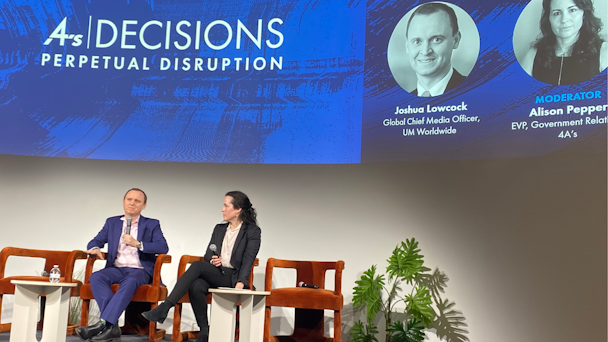Overheard at 4A’s Decisions ’23: 'We must blend old & new school attention metrics'
The TikTok swirl, tech regulation, talent: it was all part of the conversation at the 4A’s IRL annual conference in New York this week.

UM Worldwide’s Joshua Lowcock says, ‘expect the TikTok swirl to continue’
Ad, marketing and tech leaders convened within Manhattan’s financial district for the live and virtual 4A’s Decisions: Perpetual Disruption conference. From “cord stacking” to the Google’s antitrust issues to talent retention, top leaders shared a flurry of key insights and provocative opinions. Here are some of the key sound bites from the event.
We'll be updating this story throughout the conference on February 1 and 2.
Jordan Shlachter, head of measurement and insights, Activision Blizzard Media
“We have to figure out how we blend the new school metrics with the old school metrics. Things like biometrics that track mood, and things like eye tracking, to track attention are great, but aren't yet scalable. There are companies that are working on it. But [we need to] come to a point where we agree on what attention means. And that it is still a bit of a proxy metric – because that attention has to be linked to some sort of business objective. So that's what we're trying to solve. I mean, if I'm giving you full viewability, I'm giving you video complete [rates], I'm giving you high levels of ad recall – and then I can show you gyroscopic data to tell you the angle that somebody was watching that video [on their device] to show they didn't put it down on a table – that feels like a pretty good form of retention.”
Mike Dean, managing director, Deloitte
“As long as there is an Upfront – and that's an open question – but as long as there's hundreds of millions and billions of dollars transacting over a period of a few weeks, you will need something against which you can make those decisions without knowing brand allocations, without knowing audience targets, without knowing all of the things that have typically come into advanced audience planning or TV buys. And that's one of the changes that will have to take place – there will have to be a way to take new currencies and be able to predictably forecast out 18 months on the ways that we think about allocating and traunching out inventory in order to be able to do that during the Upfronts.”
Jon Watts, managing director, Coalition for Innovative Media Measurement
“For agencies, there's a chance to have better, more productive conversations with clients to innovate in the measurement space and to deliver a whole set of downstream products, which many measurement vendors are increasingly [doing]. Being able to offer clients that optionality and to be able to build out and innovate new solutions with different currency-grade measurement vendors is a boon for agencies. It should open up new, more productive opportunities to deliver better things to clients.”
Dylan Mabin, president, Geopath
“[When it comes to measuring out-of-home media], we've moved from collecting traffic [data] collected with hand clickers or sensors. Now, as technology is pervasive in every aspect of our lives, we have continuous counting stations that we can ingest. We have movement information from mobile devices, not to mention distributed cloud computing to be able to understand how the entire population moves as a whole and connect all these dots. It’s not just like, ‘Did we have a deterministic measurement of events happening in front of this billboard?’ – but also, ‘How does that fit in the context of everything else?’
The fantastic thing is the innovation [that’s creating the] understanding that out-of-home has the potential to be kind of like the Rosetta Stone to help with the omnichannel side of it. Because we're trying to understand every moment of every single person's life around how they move in the physical world, where they're coming from, where they're going. And then as those moments connect, [we’re trying to] help people to consume things in the context of those trips, or whenever they're at a particular location.”
Daniela Herrera, director of recruitment operations and equity, diversity and inclusion, R/GA
“One thing that the ad industry is catching up on that the tech industry has been doing for a long time is the idea of remote-only work, or giving people the option to work remotely. It opens up new opportunities to work with people we would have never had access to.
...And when it comes to talent, we need to be thinking about how to build equity into the mix. And equity is not giving everyone the same thing – it’s giving each person what they need to succeed. It doesn’t mean that a very junior-level employee will be given the same resources as a [member of the] C-Suite.”
Rema Vasan, head of global gaming business marketing, TikTok
“Gaming is going through a pretty massive shift – you'll know this if you're watching [HBO Max's] ‘The Last of Us’. There’s a lot of crossover between gaming IP and entertainment. Gaming is really entering mainstream culture because it’s becoming entertainment.”
Bill Koenigsberg, CEO of Horizon Media
“People are flexing so many new muscles that they’ve never flexed before. It’s not for everyone… you have to be a business athlete to keep up and get there. For me, it’s about training our athletes in terms of a mindset. If you’re prepared for it, you are not disrupted by it – you are part of the disruption.”
Jennifer Clarke, brand strategy director, Maytag and JennAir, Whirlpool
“AI can accelerate any type of creativity. I’ve been experimenting with ChatGPT in my work as have other strategists. [For example,] we work with niche audiences and only do research [about those audiences] every so often. We can ask: ‘Where do designers get inspiration?’ It will provide a list of 50 or 60 sources and then we can go validate it. This gives you more to time get to a higher level of creative thinking.”
Samantha Stetson, vice president, client council and industry trade relations, Meta
“Safety is absolutely paramount and 100% people-first, and the responsibility of the platforms is to ensure no violative content gets on. Where the industry has evolved to is the understanding of suitability -- that's where we have the control now to look at the brands’ sensitivity, and really implement what makes the most sense for their preferences. Through GARM we have common definitions, common measurement, common tools and independent verifications – and those four things together set us up for success.”
Advertisement
Ellen Kiernan, global CEO, Mediabrands
“We need to reclaim some of the magic of what it means to be an agency. It’s a rollercoaster – and if we like rollercoasters, and many of us do, we have to reclaim that [joy].”
Jason Brum, group vice-president, agency partnerships, DirecTV
“It isn’t so much about cord cutting. It’s about cord stacking. Consumers have four-plus video-on-demand (VOD) services and 63% of VOD subscribers have cable or a live streaming service subscription. The winner will be the one that brings the most value to the customer in a frictionless way. Entertainment is getting complicated in a way it shouldn’t be. It should be a way to relax versus jumping from service to service. [Plus], when people examine [their bills amid] the economic headwinds, [you may find that] by cutting the cord you could be spending more for the content than you want.”
Advertisement
Brandon Kraham, vice-president, global search ads and commerce, business and product strategy, Google
“As we lean more into automation, another wave of change management is required within enterprises. When you look at leaders and laggards, there are three characteristics of leaders:
-
C-suite alignment: the ability of leaders to create the conditions for organizations to move through change;
-
Scaling capabilities: what is needed to build human capabilities and tech capabilities and much more; and
-
An always-on mindset: [you have to be able to] scale when you start to see the green shoots.”
Scott Hagedorn, global chief solutions architect, Publicis Groupe
“Change management is tough. Trying to change the model and replace rote tasks with something more automated is a tough business. It’s a tough sell to the client when you’re trying to change the team model and compensation structure.”
Suggested newsletters for you
Joshua Lowcock, global chief media officer, UM Worldwide
“We need regulators to act and we need to step back and stop inflaming the issues. Get to the fundamental issue that consumers demand and expect privacy. We need privacy regulation that enables that. It all becomes finger-pointing and shifting blame when we talk about anti-competitive behavior. Let’s all just agree to join hands and walk in the direction of [privacy regulation].
Predictions for the future? You’ll see changes in the go-to-market behavior from Google in the short-term that will give sense there is competition in the market. The TikTok ban will continue to swirl. If congress gets its act together… there will be an increased focus on the sensitivity of data. And e-mail as an identifier is dead. We just don’t know it yet. Every trend suggests that. My recommendation is if you are still looking at addressable data and using e-mail as an identifier, plan for it to be gone by the end of the year.”
Additional reporting by Kendra Clark.
For more, sign up for The Drum’s daily US newsletter here.

